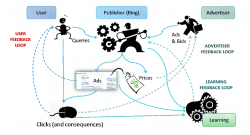Table of Contents
Counterfactual Reasoning and Learning Systems
Variants of this talk were given in several occasions, including the Machine Learning Summit 2013, the TCE 2013 Conference, and the Yandex School of Data Analysis 2013 Conference. See also lectures 9 and 11 in the 2013 NYU course on Big Data and Machine Learning.
Summary
 Statistical machine learning technologies in the real world are never without a purpose. Using their predictions, humans or machines make decisions whose circuitous consequences often violate the modeling assumptions that justified the system design in the first place. Such contradictions appear very clearly in computational advertisement systems. The design of the ad placement engine directly influences the occurrence of clicks and the corresponding advertiser payments. It also has important indirect effects : (a) ad placement decisions impact the satisfaction of the users and therefore their willingness to frequent this web site in the future, (b) ad placement decisions impact the return on investment observed by the advertisers and therefore their future bids, and (c) ad placement decisions change the nature of the data collected for training the statistical models in the future.
Statistical machine learning technologies in the real world are never without a purpose. Using their predictions, humans or machines make decisions whose circuitous consequences often violate the modeling assumptions that justified the system design in the first place. Such contradictions appear very clearly in computational advertisement systems. The design of the ad placement engine directly influences the occurrence of clicks and the corresponding advertiser payments. It also has important indirect effects : (a) ad placement decisions impact the satisfaction of the users and therefore their willingness to frequent this web site in the future, (b) ad placement decisions impact the return on investment observed by the advertisers and therefore their future bids, and (c) ad placement decisions change the nature of the data collected for training the statistical models in the future.
Popular theoretical approaches, such as auction theory or multi-armed bandits, only address selected aspects of such a system. In contrast, the language and the methods of causal inference provide a full set of tools to answer the vast collection of questions facing the designer of such a system. Is it useful to pass new input signals to the statistical models? Is it worthwhile to collect and label a new training set? What about changing the loss function or the learning algorithm? In order to answer such questions, one needs to unravel how the information produced by the statistical models traverses the web of causes and consequences and produces measurable losses and rewards.
This talk provides a real world example demonstrating the value of causal inference for large-scale machine learning. It also illustrates a collection of practical counterfactual analysis techniques applicable to many real-life machine learning systems, including causal inferences techniques applicable to continuously valued variables with meaningful confidence intervals, and quasi-static analysis techniques for estimating how small interventions affect certain causal equilibria. In the context of computational advertisement, this analysis elucidates the connection between auction theory and machine learning.
Links
- Slides: (djvu, 1.1MB) (pdf, 2.8MB)
- Technical report: Counterfactual Reasoning and Learning Systems
